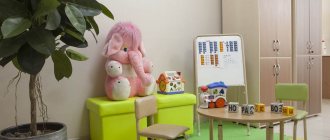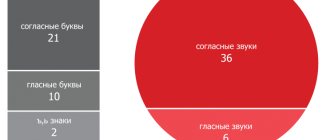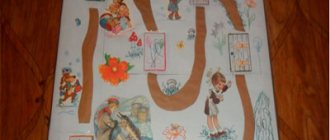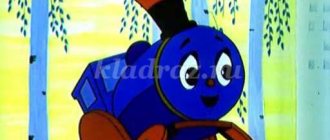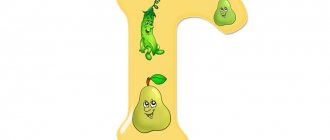Rules of the game Match and name
The game is played by one of the adults: a kindergarten teacher, a teacher, one of the parents. During the game, he monitors the children’s speech, corrects mistakes and ensures the correct pronunciation of all sounds.
Before starting the game, print the attached materials twice. Colored cards must be cut along the lines into 108 small cards. The second copy will be the uncut playing field.
1 game option
The presenter distributes large cards to the participants in the game, then shuffles the cards and, showing them to the children in turn, asks which of them has this item drawn on the large card. For example: “Who has a teapot on the map?” The one who has the corresponding drawing says: “The teapot is drawn on my map.” He takes the card from the presenter and covers the drawing on the large card with it.
The winner is the one who covers the pictures on his card (or cards) first.
Game option 2
The presenter reads out loud one of the sentences given below. One of the players repeats it and selects cards that correspond to the objects named in the sentence. For example, the presenter reads the sentence: “The dog barks at the owl.” The player must choose from the cards laid out on the table those on which a dog and an owl are drawn.
Then the presenter reads the next sentence, and the cards are picked up by another player.
3 version of the game
On the instructions of the presenter, children must select various cards based on some common characteristics (for example, birds, pets, clothes, vegetables, etc.), naming each item out loud.
4 version of the game
Players answer the host's questions by looking for corresponding pictures on cards or cards. Sample questions:
- Who's meowing?
- What grows in the garden?
- What do you use to saw and chop wood?
- What animals live in hot countries?
When determining the winners, the speed of response, correct pronunciation of words, and the ability to quickly find corresponding pictures are taken into account.
5 version of the game
The presenter lays out 3 to 10 cards on the table. One of the players must name each card. After that, he turns away, and the presenter removes some of the cards. The player, looking at the table, must say which cards are missing.
You can complicate the game: the presenter removes all the cards, and the player must name all of them from memory.
Those who make the fewest mistakes win.
6 version of the game
Children take one card at a time, name the drawn object and come up with a sentence with the name of this object.
At random or at the choice of the leader, players take turns taking several cards and verbally making up a short story, which should include the names of the objects drawn on the cards.
Essentially, this is a variation of the game Story Cubes.
When identifying the winner, the colorfulness of the story is taken into account.
7 version of the game
For this game you will need the alphabet. You can do it yourself.
The presenter lays out small cards on the table with the image facing up. Then he places on the table two letters from the alphabet, which represent sounds that the child often mixes up. For example, “S” and “W”.
The first player first selects cards with pictures whose names contain the letter “C”. After that, he picks up cards with pictures with the letter “W”. Names words.
If the cards are chosen or named incorrectly, the leader puts them aside so that the child can name them again.
Then the presenter places two other letters on the table: Z and Z, CH and C, L and R, C and C, CH and C, O and C, C and Z, I and Z.
The next participants in the game take turns picking up the appropriate cards. The game continues until all the cards have been dealt. Whoever collects the most cards wins.
Sample proposals
To the sound C
They bought Sanya a plane and a scooter.
A catfish is a fish, and an owl is a bird.
The beads were put in the bag.
Wasps fly, but catfish swim.
To the sound Z
The goat was locked up.
An umbrella is drying near the fence.
The monkey broke the vase.
The hare was afraid of the snake.
To the sound T
The chicken pecks at the button.
The chicken laid an egg.
Drive the sheep away from the flowers.
Heron and chicken are birds.
For the sounds S, Z, C
The cucumbers were placed on the scales.
Chickens and owls have no teeth.
There is an egg in the nest.
Osya sit on flowers.
To the sound Sh
The cat eats mice.
Fur coat and hat in irfaw/
The guys picked up a bag of cones.
The cat rolls a reel.
To the sound Zh
The little bear ran away from the hedgehogs.
There is a beetle on the stomach.
For hunting, dad bought a gun and skis.
A beetle is smaller than a toad.
For the sounds Ш and Ж
The guys were carrying hedgehogs in a hat.
The gun hangs near the closet.
Knives are not put in a bag.
A beetle is crawling on a cone.
To the sound Ch
The suitcase is locked with a key.
The ball fell into a barrel of water.
The butterfly sat on the wheelbarrow.
Mom bought a teapot and a cup.
To the sound Ш
A brush and pliers are necessary things.
Pike and bream are river fish.
The vegetables were put in a box.
Pincers look like forceps.
To the sound L
Pigeon and woodpecker are birds.
We saw a squirrel and a moose in the forest.
The saw and shovel are in the corner.
We dug up a bed for onions with a shovel.
To the sound R
Cancer and fish live in water.
Vova has a pen in his hand.
The lynx is a wild animal, and the cow is a domestic animal.
They bought a ball and a drum for the child.
For the sounds R and L
They saw with a saw, and they stabbed and chopped with an ax.
The squirrel hid from the lynx in a hollow tree.
The fish swam under the boat.
Lyuba has lilies of the valley in her hand.
Speech therapy lotto for automating the sound L “Halves”
Speech therapy board game – lotto “Halves”
Explanatory note
Correction of speech disorders is carried out taking into account leading activities. In preschool children, it is carried out during the process of play, which becomes a means of developing analytical-synthetic activity, motor skills, sensory sphere, enriching the vocabulary, mastering language patterns, and shaping the child’s personality.
Currently, the process of automating sounds in most cases takes a long time, so the speech therapist teacher must have in his arsenal an impressive number of games and aids to maintain the child’s interest in classes. In addition, for successful automation of sounds, speech material must be offered in a certain sequence - isolated sound, syllables, words, sentences, etc. In this case, it is optimal for a specific sound to be in one position (for example, the sound “P”: straight syllables : ra-ra-ra, ry-ry-ry, etc.; further words with the sound “R” at the beginning: frame, rainbow, fish...; sentences with the sound “R” at the beginning of words: Raya is glad for the rose. Roma glad to see the robot). However, despite the huge number of speech therapy games offered in stores and on Internet sites, it is difficult to find ones that comply with this rule. Various puzzles, lotto, walking games are designed for children who can freely pronounce a specific sound in various positions (beginning, middle, end, combination of consonants).
Based on this, specialists need to develop original games that will allow the staged sound to be introduced into the child’s speech. An example of such a game is the “Halves” lotto, with which you can automate the sound in words, phrases and sentences, depending on the speech capabilities of a particular child.
Purpose of the game:
automation of the correct pronunciation of the sound “L” in words, phrases, sentences (without a combination of consonants).
Tasks:
— automate the delivered sound in words, phrases, sentences;
— consolidate the skills of agreeing nouns in gender when composing the phrase “noun + noun”;
- develop visual perception and attention.
Equipment:
6 game sheets depicting halves of objects (8 pieces each), 48 cards depicting the second halves of objects presented on the game sheets, 48 cards depicting the first halves of objects (as on the game sheets) - for mini-games "Halves" and "Memory", bag.
Sheet 1. Eraser, shovel, boat, lasagne, bench, varnish, light bulb, tray.
Sheet 2. Boat, basket, beam, bow, magnifying glass, skis, moon, puddle.
Sheet 3. Soap, bowl, spinning top, blanket, saw, chocolate, roll, robe.
Sheet 4. Hammer, bell, tent, mousetrap, balloon, well, salt shaker, galoshes.
Sheet 5. Bell (flower), stole, pendant, cap, acorn, swamp, column, ear.
Sheet 6. Glass, pencil case, oval, chair, torch, chalk, table, dagger.
The game was created in Microsoft Office Word in spreadsheet format, printed and laminated.
The words for the game are selected in such a way that the sentence does not contain combinations of consonants with an automated sound. Images of living creatures are not used in the game.
When preparing the game, both halves of each image were printed. So the result is another mini-game called Halves that can be used individually or with a subgroup of children.
Number of players:
from 2 to 6.
Players age:
from 5 years.
Rules of the game "Loto":
Automation of the sound “L” in words:
The players take turns taking a card out of the bag and asking the question: Who has the light bulb? (soap, glass, etc.). The child who finds the right half answers: I have a light bulb (soap, glass, etc.) and puts the card on his game sheet, provided that the sound is pronounced correctly.
Automation of the sound “L” in phrases:
The players take turns taking a card out of the bag and asking the question: Who has half the light bulb? (soap, glasses, etc.). The child who finds the right half answers: I have half a light bulb (soap, glass, etc.) and puts the card on his game sheet, provided that the sound is pronounced correctly.
Automation of the “L” sound in sentences:
The players take turns taking a card out of the bag and asking the question: Who has half the light bulb? (soap, glasses, etc.). The child who finds the right half answers: I have half a light bulb (soap, glass, etc.) and puts the card on his game sheet, provided that the sound is pronounced correctly and adds: I had half a light bulb, now I have a whole light bulb.
The person who completes their game sheets the fastest wins.
Mini-game options:
"Halves."
The child (or children take turns) puts together the cut pictures and names the resulting object, correctly pronouncing the sound “L” in the word. The pictures can be shuffled and turned face down. The child opens the pictures in random order: half a robe, half a table, etc. Having collected all the pictures, you can again reinforce the pronunciation (a whole robe, a whole chair), thus automating the sound in phrases.
"Memory".
A certain number of paired halves are laid out face down. Children, in the order determined at the beginning of the game, open 2 pictures, naming them (half a pencil case, half an acorn, etc.). If the pictures match, the player names the resulting picture (a whole pencil case, a whole acorn), takes them for himself and makes another move. If the player guesses wrong, he places the cards face down in their place. The one who collects the most complete pictures wins.
Game sheets in electronic form:
Half cards in electronic form:
List of sources used
1. PNG images with a transparent background. — Access mode: https://imgpng.ru/
2. Download free PNG. — Access mode: https://www.freepng.ru/
3. Yandex.Images: search for images on the Internet, search by image. — Access mode: https://yandex.ru/images/
Print the speech therapy lotto “Pick and Name”
The authors of the game are L. Uspenskaya, M. Uspensky, artist T. Shepeleva. Publishing house “Malysh”, 1982 and 1990.
The source of the scans is listed below

